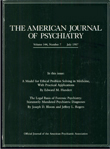Drs. Krystal and Weiner Reply
To the Editor: We appreciate Dr. Swartz’s comments underscoring that the stimulus characteristics used in our study may have affected the results. As he points out, and as we discussed in our article, some reports have suggested that shorter pulse widths and a longer duration of stimuli may be more efficient at eliciting seizures. Such stimulus characteristics might be associated with fewer than 5% of the subjects having ineffective treatments because of short seizures at the maximum available stimulus level. It should be noted, however, that to our knowledge, there have been no published studies that directly address this issue with the use of precise dose-titration methodology, and this possibility therefore remains speculative. Further, other, admittedly flawed, investigations have suggested diminished efficacy with shorter pulse widths.
Nonetheless, both MECTA Corporation, whose device we used, and their competitor, Somatics LLC, now produce ECT devices with shorter pulse widths and longer duration stimuli than we employed in our study. Using the newer device made by MECTA Corporation, we have since analyzed new data from 49 subjects. These subjects received a recent clinical index ECT course administered like those in our study, except that a briefer pulse width (1.0 versus 2.0 msec) and a maximum stimulus of longer duration (6.0 versus 2.0 sec) were employed. Fourteen subjects (29%) required the maximum intensity stimulus, and five (10%) had a short seizure at the maximum stimulus level. These preliminary results do not suggest a “substantially lower” failure rate; however, it remains undetermined whether this might be true with even shorter pulse widths.
Thus, to our knowledge, no data exist suggesting that our results apply only to the MECTA device used in our study. Of more importance, to our knowledge, no studies contradict our conclusion that there is a need for higher maximum stimulus intensities. This conclusion is also supported by recent compelling independent findings by others (1–3).
With respect to the present maximum U.S. stimulus intensity, as we noted, the FDA limited U.S. ECT devices to a maximum intensity before FDA regulation. For MECTA devices, there is a maximum charge of 576 mC versus 504 mC for devices made by Somatics. Since we reported the maximum allowable charge for U.S. devices, the former figure was used. The limitation of 100 J at 220 Ω of impedance referred to by Dr. Swartz reflects a standard once adopted by the International Electrotechnical Commission for ECT devices that has since been withdrawn.
The authors are the inventors listed on a U.S. patent that Duke University has licensed to MECTA Corporation. Neither receives royalties from this patent.
1. Sackeim HA, Prudic J, Devanand DP, Nobler MS, Lisanby SH, Peyser S, Fitzsimons L, Moody BJ, Clark J: A prospective, randomized, double-blind comparison of bilateral and right unilateral electroconvulsive therapy at different stimulus intensities. Arch Gen Psychiatry 2000; 57:425–434Crossref, Medline, Google Scholar
2. McCall WV, Reboussin DM, Weiner RD, Sackeim HA: Titrated moderately suprathreshold vs fixed high-dose right unilateral electroconvulsive therapy: acute antidepressant and cognitive effects. Arch Gen Psychiatry 2000; 57:438–444Crossref, Medline, Google Scholar
3. Abrams R: Electroconvulsive therapy requires higher dosage levels: Food and Drug Administration action is required. Arch Gen Psychiatry 2000; 57:445–446Crossref, Medline, Google Scholar



